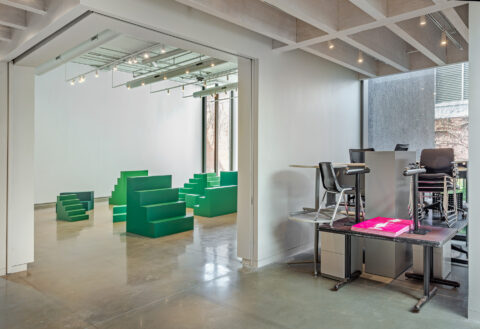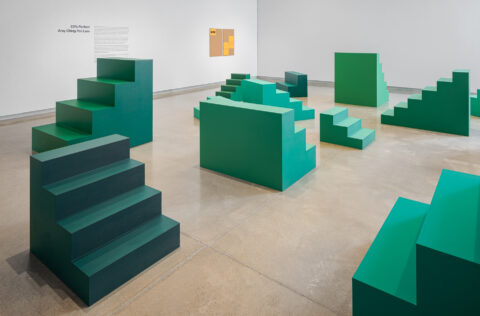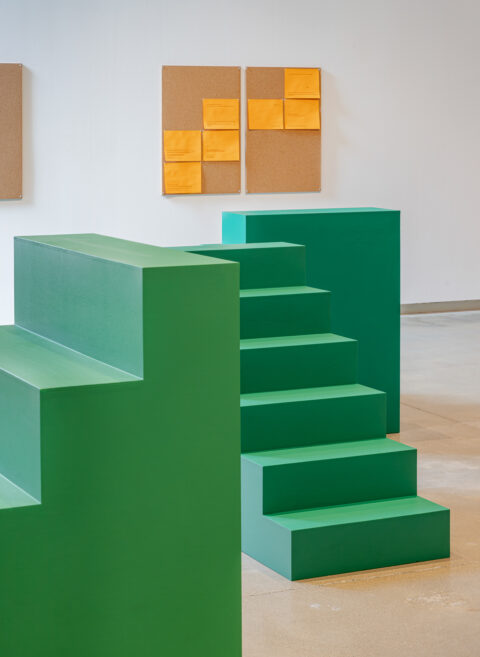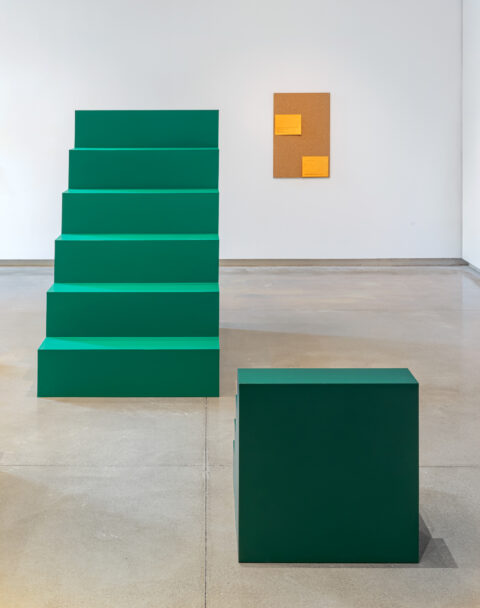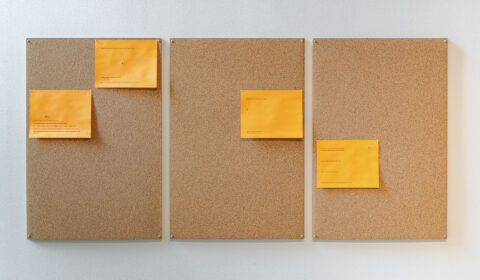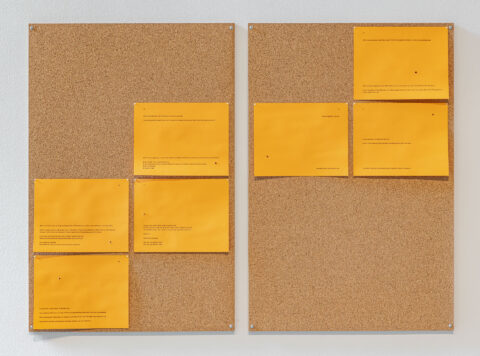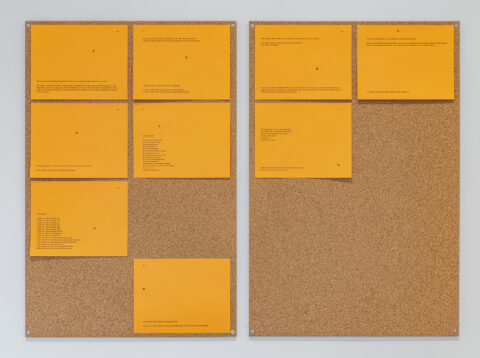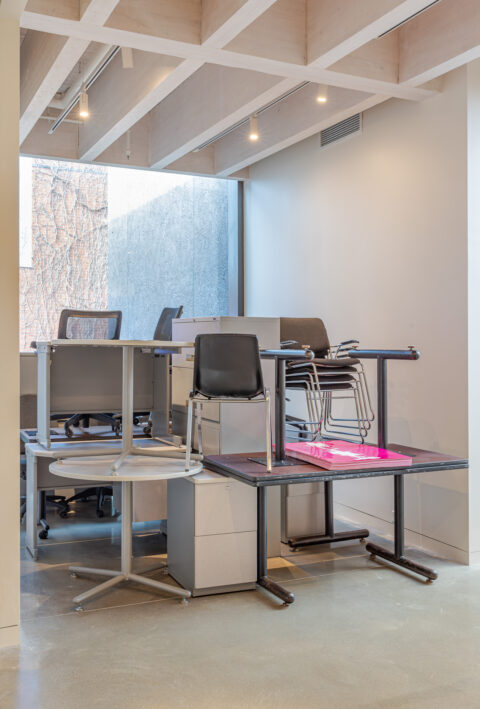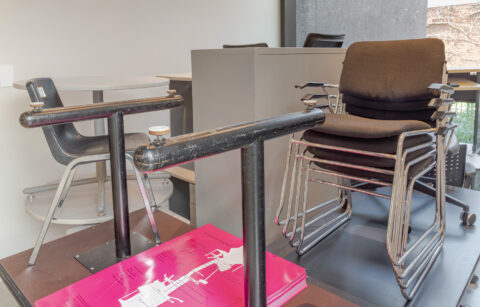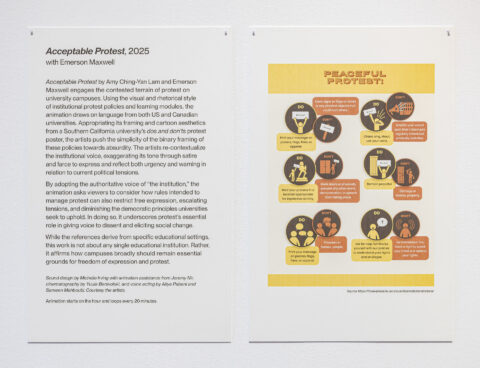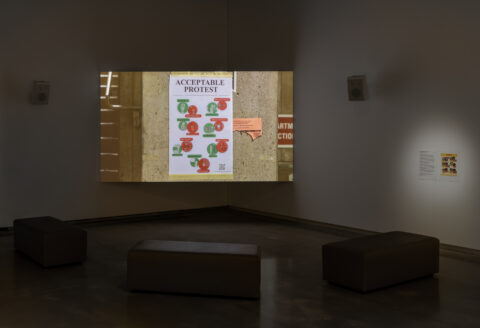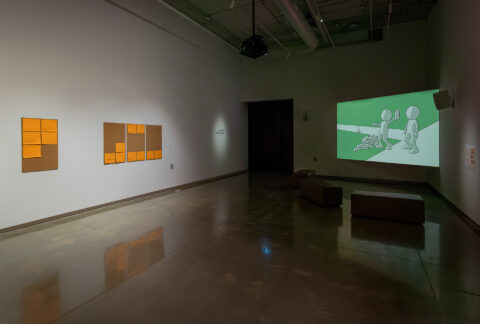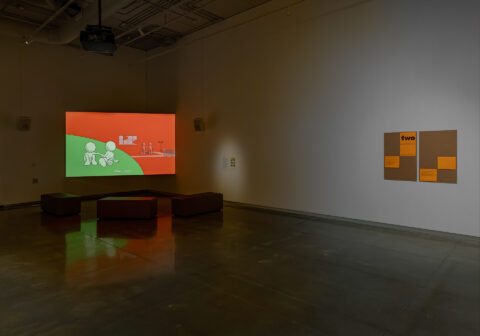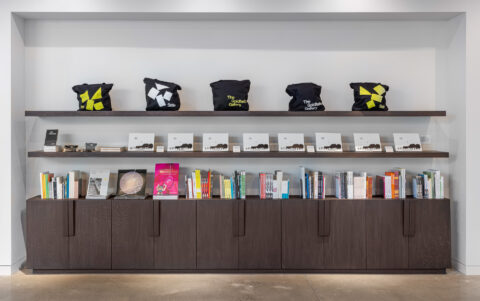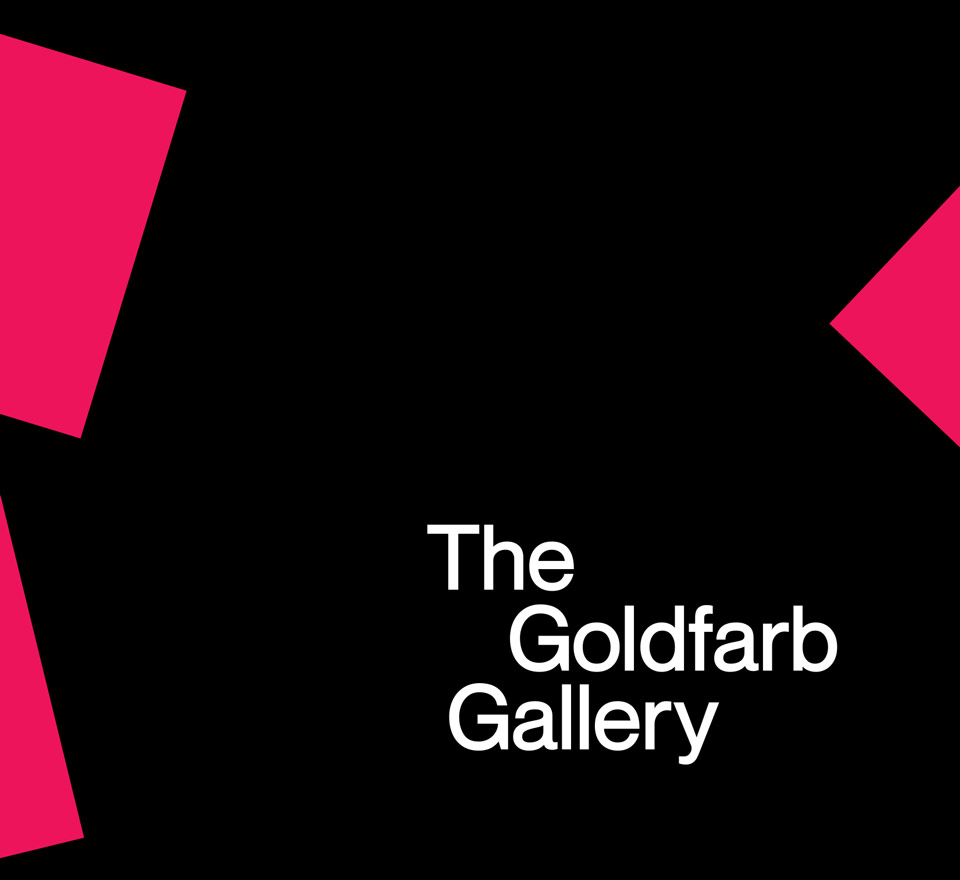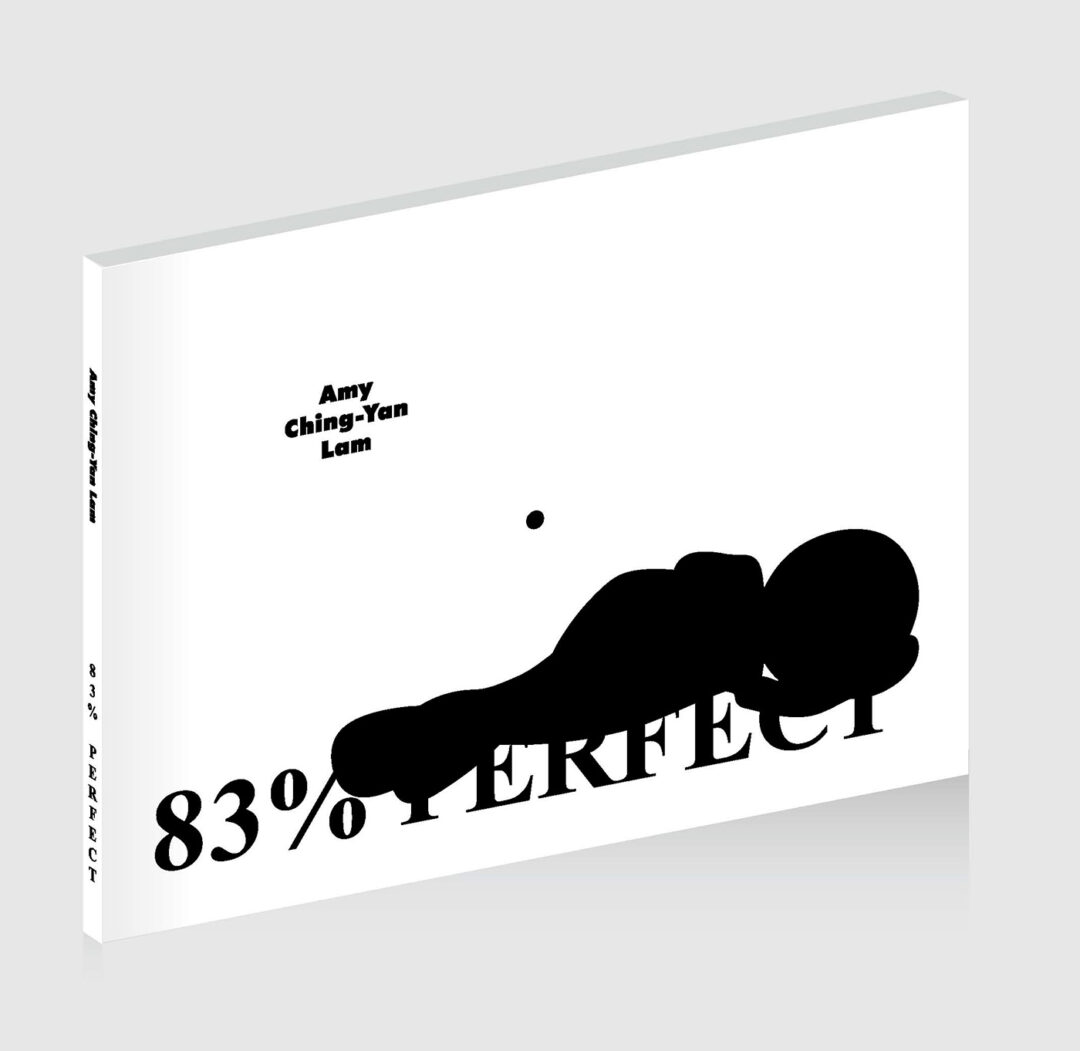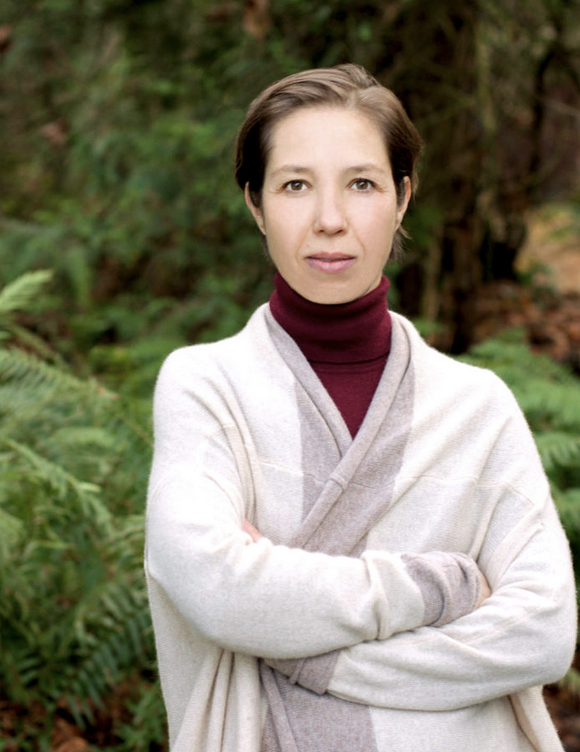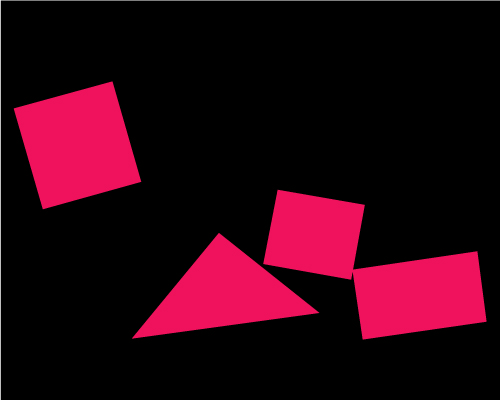September 26, 2025 – January 31, 2026
83% Perfect
Amy Ching-Yan Lam
Rectangle and Square galleries
1) any shape is created by its negative space
2) a shape cannot be changed by another’s negative space
3) the negative space of negative space is the total shape of the world
— Amy Lam (1)
… The implication is that anything that can’t be remembered is somehow the result of trauma.
— Mike Kelley (2)
A defining but equivocal childhood memory of a green detached staircase is the kernel from which Amy Ching-Yan Lam’s exhibition 83% Perfect germinates. The physicality of the staircase itself is vague: was it three steps or six, was it emerald or forest green, was it 6 feet high or only 2? But Lam’s encounter with the nebulous green staircase is ingrained as her first test, the beginning of her education, and an introduction into an institutionalized system that proports to find and celebrate one’s potential. This potential, measured as aptitude through the ability to reproduce knowledge and navigate prescribed pathways, carries the paradoxical effect that the very act of testing may prove more formative in defining potential than the abilities which are tested.
Lam recounts this indelible memory of her first test in a fable she has written for the exhibition as part of an accompanying publication. Through the character OhNo, Lam describes “three nuns wearing matching outfits with headpieces, sweater vests, and skirts, observing OhNo. OhNo was instructed to walk up the steps by themselves.” While the test was obviously stressful for the artist, who was only three years old when examined, Lam’s recollection isn’t simply about recounting a fearful moment. The retelling of this steadfast memory also relates to her drive to do well and her determination to pass. In a quote from Lam’s artist statement, she reveals that “an astrologer once told me that I was born under the banner of ‘I have to be perfect.’ She said that this is the key imperative that I have lived with since birth.” Recounting and re-imagining Lam’s first test becomes a means to understand the need to be perfect, where it comes from, how it is taught, and how to unlearn it.
The title 83% Perfect is a contradiction. 83% references a grade defined by some classifications as scoring just below the mark of ‘A’, shy of excellence and less than perfect. 83% is the mark of a good student, a high achiever, but also the reminder that one could do better, work harder. That perfection is still not yet achieved. The combination of these close but counter signifiers in Lam’s title implies perfection can only ever be imaginary, as in her uncanny installation First Test, where Lam re-imagines the object from her first test in a maze-like assemblage of numerous detached stairs varying in number of steps, scale, and shades of green. Each step structure is a variation, capturing the ambiguity of the artist’s memory, but also embodying a refusal to represent the singularity of what happened and its effect. The installation inversely offers a topography of attempts, a choreography of ascending and descending, a multiplicity of tests, and a plethora of potential successes and failures. The installation is meant to be moved through, not climbed, creating a visual field of possible right answers—one structure perhaps most true to Lam’s experience, capable of clarifying her memory. Or inversely, does the installation complicate and disrupt the artist’s own imagination of that moment, now always confused by so many possibilities?
Lam’s reconstitution of the green stairs is in quiet conversation with Mike Kelley’s 1995 artwork Educational Complex in which he built a scale model of every school he attended and his childhood home — leaving out the parts he could not remember. For Kelley, omission was a conceptual material, charged by 1990s debates over repressed memory and abuse, and by the cultural nostalgia surrounding childhood. (3) Lam references Kelley’s architecture of partial recall, but shifts the frame. Her reconstructions are full-scale structures, some being larger than life-size — architectural enough to hold the body, performative enough to implicate visitors. Both Kelley and Lam trace the complexity of memory shaped by institutional educational systems steeped within the ideology of individual achievement. The imperfections of memory become sites of meaning not to contest the mind’s fallibility but to question the systems that produce subjects that conform to criteria of rights and wrongs, of dos and don’ts, which determine failure and success.
In 83% Perfect, this early lesson is set alongside another institution of educational authority in the animation Acceptable Protest. The university is the pinnacle system of education, dedicated to fostering knowledge through critical thought and civic engagement but also in defining what is taught and learned, and, most importantly, in setting individual paths forward. With her collaborator Emerson Maxwell, Lam has created a comical and critical juncture tied to freedom of thought and expression by weaving together official protest policies from universities across Canada and the US. The animation starts with a poster from a Southern California university that outlines the dos and don’ts of acceptable protests on its campus, bringing to life the poster’s rudimentary cartoon figures in humourous and absurdist illustrations of what are and what are not acceptable forms of protest. Protestors are allowed to print their messages on posters, flags, fliers, and apparel but are not allowed to use sticks to wave or carry their posters or flags. They are given permission to chant, sing, and shout but not to mechanically amplify their voices. Ultimately the dos and don’ts undo each other as the various forms of protest reach their limits.
Tied to the animation is Furniture for Three Doors, a site-specific work massed in the nook of the gallery’s reception. For this piece, Lam presents a stacked selection of furniture collected from one of York University’s makeshift storage spaces for surplus furnishings. File cabinets, desktops, tables, and seating are neatly ordered in the space, as well as a written list of all the gallery’s furniture currently in use in the building. The amassed furniture is a calculation of what would be needed to barricade the gallery’s three entrances. In this work, protest is imagined as an always latent possibility embedded in the institution’s own holdings, architecture, and ethics, and a reminder and nod to the gallery and the university as possible sites of action, expression, and resistance, making the barricaded space a site of gathering rather than isolation.
The accompanying publication sets the stage for this exhibition but also transcends it, offering an intimate glimpse into Lam’s formative experiences, using the personal to capture the political undercurrents the exhibition posits. Lam’s fable-like writing is presented poetically across brown kraft paper pages, evoking children’s colouring books. Prints of the book’s pages are dissected and displayed across 23 corkboard panels, presented in two chapters: the first lyrically augments the sculptural installation First Test while the second accompanies and charges Acceptable Protest, weaving both pieces together in a circularity of individualism and exceptionalism that underlies both the educational complex and the gallery system. Lam’s exhibition does not resolve these tensions but inhabits them with a critique meant to reveal their repressive natures pulsing underneath, counter to their imagined functions to give voice, share space, and be open to all.
Notes:
1. ↺ Amy Lam, 83% Perfect (The Goldfarb Gallery, 2025), 22.
2. ↺ Mike Kelley in John Miller, Mike Kelly: Educational Complex (Afterall Books, 2015), 8.
3. ↺ Ibid., 13.
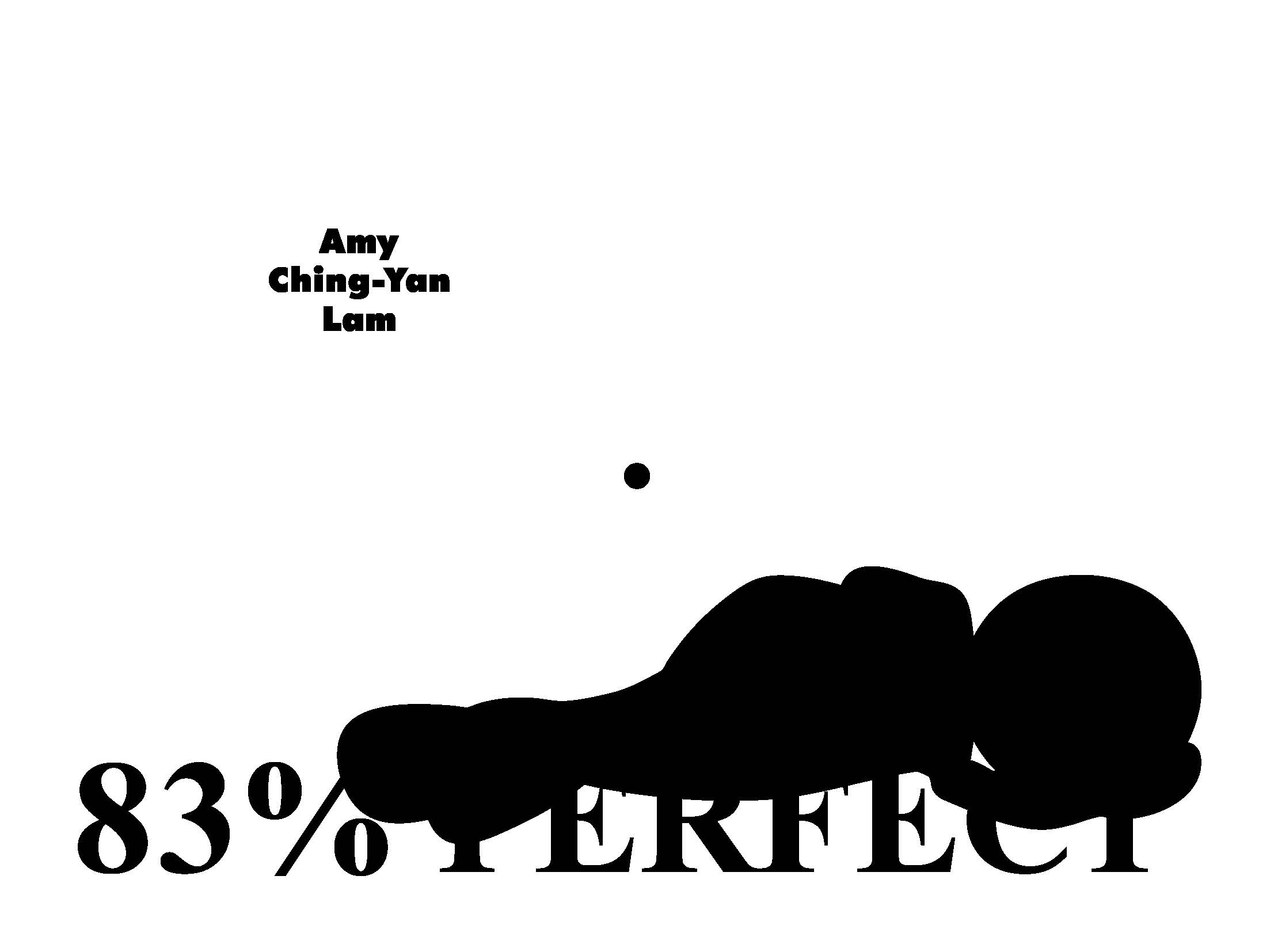
Amy Ching-Yan Lam, 83% Perfect, 2025. Adapted bookcover by Rosen Eveleigh. Courtesy the artist.
Amy Ching-Yan Lam is an artist and writer. Her practice looks at how dominant social and political orders are naturalized, where they reside, and how they can be understood through intuition and feeling. She frequently works in collaboration with other artists, designers, and writers. She is the author of Property Journal (Book Works, 2024), a journal documenting conversations and experiences of property; Baby Book (Brick Books, 2023), finalist for the Governor General’s Literary Awards in Poetry; and Looty Goes to Heaven (Eastside Projects, 2022), a historical fiction about a small dog stolen from China by British soldiers. Exhibitions, performances, and screenings have been presented at Richmond Art Gallery, 2023; Eastside Projects, UK, 2022; Seoul MediaCity Biennale, 2021; SFU Galleries, 2021; Centre Clark, 2019; Truck Gallery, 2018; AKA artist-run centre, 2018; Western Front, 2015; Art Gallery of Ontario, 2013; and many others in so-called Canada. From 2006 to 2020, she was part of the performance art duo Life of a Craphead.
Installation team for exhibitions: Uroš Jelić (lead), Corinne Carlson, Jonah Kamphorst, Matthew Koudys, Joseph Thomson, Manny Trinh, Morgan Zigler
This exhibition is curated by Jenifer Papararo, featuring all new work commissioned by The Goldfarb Gallery. Amy Ching-Yan Lam received funding from The Canada Council for the Arts and an Artist-Direct grant from Partners in Art to support the research and production of this exhibition as well as to host a series of writing workshops for York University students. Audio Description will be available at the gallery and online, written by Robin Simpson and produced by Rebecca Singh. Lam collaborated with Emerson Maxwell for Acceptable Protest, with sound design by Michelle Irving, animation assistance from Jeremy Nir, cinematography by Yuula Benivolski, and voice acting by Aliya Pabani and Sameen Mahboubi. Rosen Eveleigh designed the publication. Additional research and writing support was provided by Jody Chan.
See also:

